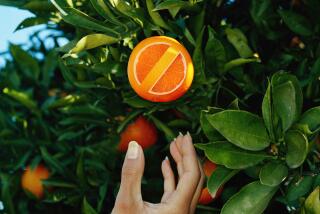Precious and Few: Pears
- Share via
The bad news is that this year’s pear harvest will probably be scarcer than any since 1969. The good news is that what pears there are will be super.
The 1996 winter pear harvest in Washington and Oregon--the two states account for about three-fourths of the country’s pears--is expected to be down about 20% from last year. Washington’s Bartlett pear harvest--tracked separately--will be a whopping 46% less than last year.
California’s harvest--about 15% of the national total--will be about 12% below its five-year average. That’s about 5,000 tons less than last year’s harvest, which was considered a disaster.
But there are bright spots. First, though California’s total harvest is less than last year’s, the amount of pears sold fresh will be much higher because of the crop’s exceptionally high quality. Last year’s fruit was so weather damaged that much of it had to be sold for processing.
The high quality of the fruit is a result of the smaller size of the crop. Unseasonably warm weather in California last winter hindered the creation of flowers and young fruit. As a result, the trees had to support fewer pears, making this year’s fruit larger and higher in sugar.
“Even though our harvest is short, we have had probably the best quality fruit we’ve ever had,” says Chris Zanobini, executive director of California Pear Advisory Board. “We have been extremely fortunate. We have very nice fruit this year.”
There are two distinct pear harvests in California. The first is in the flatlands of the Sacramento River Delta and takes place in late July. The best is in the mountain district of Lake and Mendocino counties. That one wound up the first week of September.
Pears are one of the few fruits that must be harvested to ripen. They are picked when they reach a certain size, then sorted, boxed and frequently shipped unripe to grocery stores, where they are allowed to mature.
Although there are many ways to test the ripeness of a pear, the easiest is by color. An unripe Bartlett pear--the major variety in California--is green. A ripe pear is golden yellow. When pears are green with streaks of yellow, they are said to be “breaking” and will be ripe in a couple of days.
Zanobini says the best way to ripen green fruit is simply to leave it on the counter at room temperature. When it turns golden, you can refrigerate it until you’re ready to eat it. Sticking the fruit in a brown paper bag will speed up the ripening process (the bag traps the pear’s ethelyne gas, speeding maturity).
But he warns there are drawbacks: “It does work, but people tend to put something in a paper bag and forget about it. Then they open it up a couple of days later and wind up with pear surprise.”
More to Read
Sign up for The Wild
We’ll help you find the best places to hike, bike and run, as well as the perfect silent spots for meditation and yoga.
You may occasionally receive promotional content from the Los Angeles Times.







